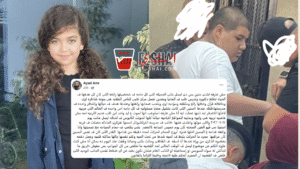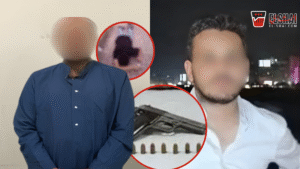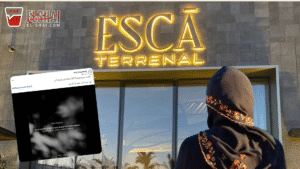Imagine a loved one gets brutally killed, and before you’re even done grieving, you’re watching a group of mediocre filmmakers have the time of their lives shooting a film about their death. Not just that, but they’re making jokes, adding emojis to the news of hiring an “action designer” to choreograph scenes of torture, murder, and rape.

The designer is thrilled about the job. He jokes on the announcement post: “Rape, cannibalism, and eating orphans’ money. It’s an honor for me, and God willing, we’ll do something that will rock the world.” Because apparently, rape is hilarious.
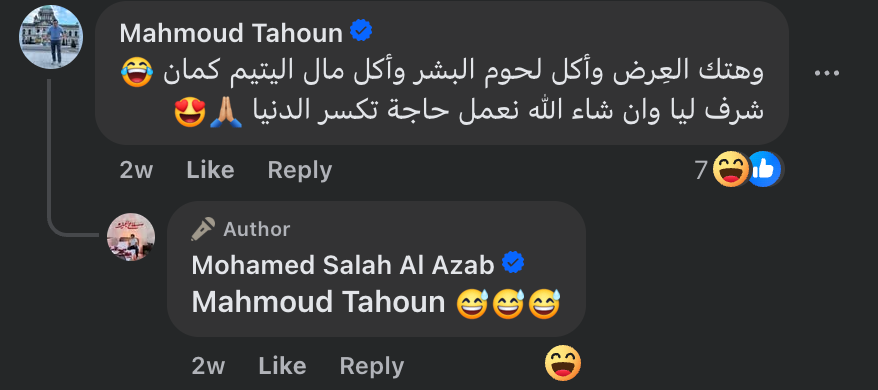
People in the comments are eager to join in. One writes: “Rape! You need new faces. I’m a human wolf now.”
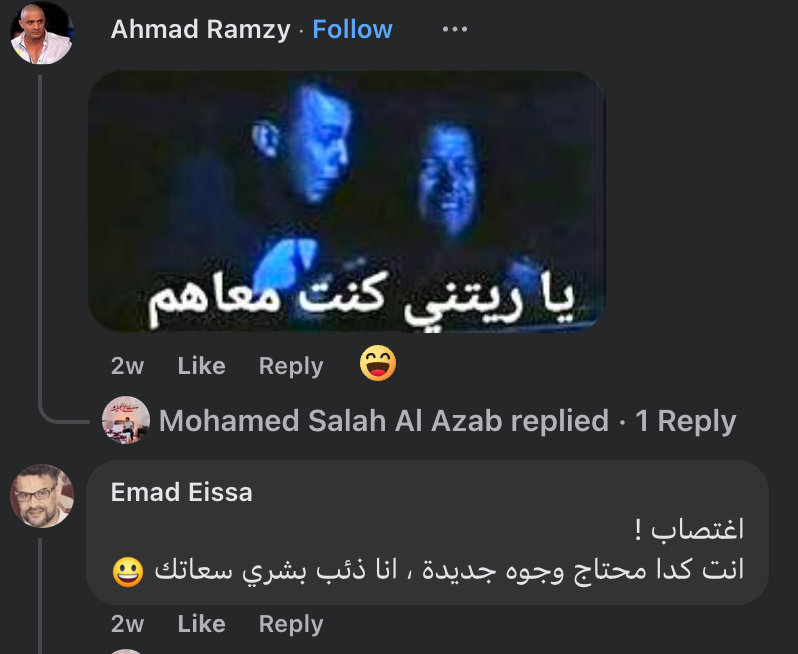
Everyone wants in on the rape.
And all of this excitement? It’s not for some twisted work of fiction. It’s for a film based on one of Egypt’s most brutal recent crimes.
Less than a year ago, Egypt was shaken by the case of Karim Selim, the man dubbed the “Safah El-Tagamoa.” Three women were murdered. A trial captivated the nation. A mother fought for years to get her child back from the killer’s family. And now, a movie about it is already in the works.
The film, produced by Ahmed El Sobky, is written and directed by Mohamed Salah El Azab, the same man responsible for the controversial series Safah El-Giza. El Azab first announced the project as soon as the real-life case went public, promoting it as a “lighthearted” project and making light of all the lives lost.
The film, starring Ahmed El Fishawy, was officially announced in late July 2025. El Fishawy revealed the teaser poster on Instagram with the caption: “Wait for Karim in Safah El-Tagamoa… a film written and directed by Mohamed Salah El Azab and produced by Ahmed El Sobky.” Filming is set to begin in August 2025 in Tagamoa and Cairo, with a projected release date in 2026.
This timeline is not just bad; it’s actively tone-deaf.
The Case Itself
The film is based on the true story of Karim Selim, who was accused of killing three women in cold blood in May of last year. The investigations revealed he would lure victims to a soundproof apartment, torture them, force them to take fatal drugs, and then document his crimes on video.
The case shocked the public with its brutality, and Selim was ultimately sentenced to death, a ruling that has been upheld twice. The film aims to provide a dramatic treatment of these events while adding a degree of fiction.
The media coverage so far has been a mix of suspense and reservation. While many outlets highlight the “thrilling” nature of the story, some critics and commentators have expressed fears that the film is “a commercial investment in a human tragedy” that could encourage violence.
El Azab’s Controversial Track Record
Before we get into Safah El-Tagamoa, it’s crucial to understand El Azab’s history with the true-crime genre. His 2023 series, Safah El-Giza, was also inspired by a real-life killer and faced significant backlash.
The real-life sister of the “Giza Butcher” objected to the first two episodes, claiming the portrayal “violated the real-life story and did not respect his family’s history.”
El Azab’s defense was that the series was based on police records and aimed to restore dignity to the victims, not glorify the killer.
This didn’t stop him from publicly criticizing his audience and fellow artists.
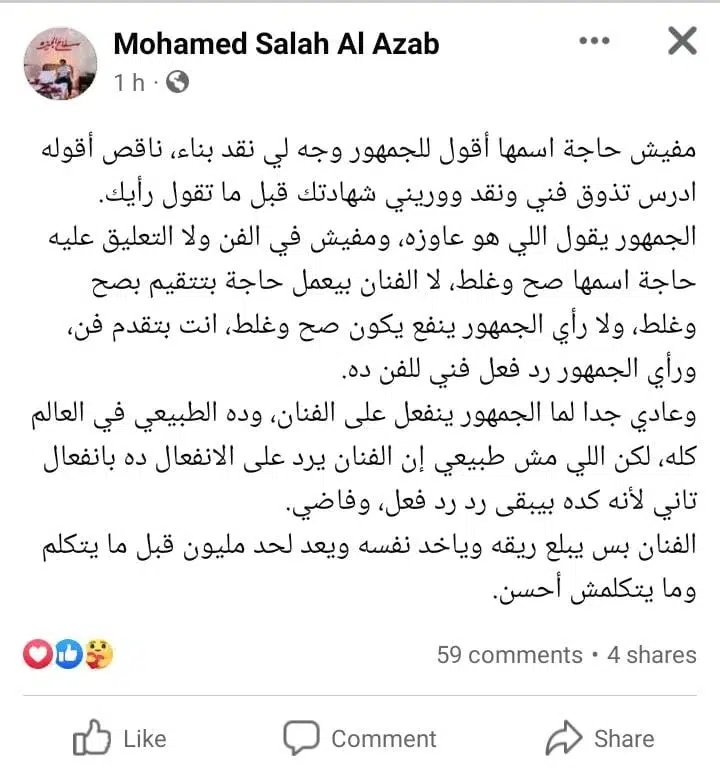
In a now-famous Facebook post, he expressed his strong disapproval of artists who can’t handle feedback, arguing that
“there is no such thing as ‘give the audience constructive criticism.’”
He asserted that an audience’s reaction is simply “their artistic response,” implying he was beyond reproach—a bold stance for an artist, as criticism is a fundamental part of the creative process.
The Creative Clash That Happened during Safah El-Giza That You Didn’t Hear
The controversy behind Safah El-Giza wasn’t limited to public opinion. El Azab publicly called out the series’ director, Hadi Al-Bajouri, for overstepping his role. Yes, the director, who’s the pilot of any creative work, was overstepping, according to El Azab.
He claimed the director altered the ending without his approval, adding a new dramatic arc focused on a character named Nour, which El Azab believed was done for “compliments” rather than story logic. He accused Al-Bajouri of creating an ending that “wasn’t what I wrote at all” and insisted he would never work with him again.
The conflict stemmed from a tense writers’ room where the director ultimately favored the contributions of another writer, Injy Abou El So’oud.
Now, if you’re confused by this, let us explain further how the writing process went.
Mohamed Salah El Azab was officially credited as the “creator” and main writer of Safah El-Giza. This means he came up with the concept, overall story arc, and primary script drafts. But the production didn’t move forward with him writing alone.
Producers brought in a writers’ workshop, led by Injy Abou El So’oud with Emad Mutter, to help refine, adapt, and complete the scripts.
A writers’ workshop in TV typically functions like a collaborative room: they take the main writer’s outlines or scripts and break them into episodes, adjust pacing, build dialogue, and sometimes change story beats to better fit production or audience needs.
This is where the friction started. El Azab saw the story as his own creation and wanted control over how it ended and how the characters were portrayed. Injy and Emad were working under the director’s guidance and, as the workshop, had the authority to make significant changes — including altering the ending. Hadi El-Bajouri (the director) sided with Injy and Emad on these changes, including adding a new subplot for a character played by the producer’s wife.
To El Azab, this wasn’t just a creative tweak; it was a hijack of the ending he envisioned. To the workshop, this was standard collaborative practice under the showrunner/director’s direction.
And this is proof that so many creatives don’t actually understand their roles in productions.
El Azab was only to write the overall draft, and the workshop and director as responsible for the final product. If he has an issue with this flow, he should not have been involved in the first place. But publicly slandering what the other creatives were doing on something that was agreed on is not just unprofessional, but it’s shameful.
That’s important context when looking at Safah El-Tagamoa.
This isn’t just another project for El Azab, it’s his first time directing a film, and it comes right after the high-profile disputes and public defensiveness of Safah El-Giza. The way he’s approaching it, from the moment it was announced to the way it’s being marketed, shows that he hasn’t changed course. If anything, he’s doubling down.
Which brings us to the main topic of Safah El-Tagamoa; a project that feels like the same playbook, just on a bigger stage. This time, El Azab isn’t just writing; he’s directing. And instead of learning from the backlash of Safah El-Giza, he’s leaning harder into sensationalism.
The way the film has been teased so far makes it look less like a sensitive retelling of a fresh tragedy and more like a marketing campaign built around a killer’s persona.
A Tragedy Becomes an Ad Campaign
The promotional tone is concerning.
El Fishawy has posted videos mimicking the killer’s own real-life TikTok content, complete with his sarcastic mannerisms. He accompanied one video with a caption: “From the original TikTok videos of the Tagamoa butcher… filming soon.” The director, El Azab, teases lines like “Don’t be scared, but be terrified.”
This is all marketed as a thrilling, gritty ride. But this is not fiction. It’s the reenactment of a crime that left real women dead, a child without a father, and families shattered. The “thriller” framing risks crossing into glorification, especially when you play up the killer’s persona for online engagement.
And, oh honey, it gets worse.
Let’s turn rape into a punchline!
Now back to the rape designer—or sorry, the “action” designer.
The level of disgust and anger you can get from his post is beyond anything we can explain. Everyone is making light not just of rape, but of the rape of victims who were murdered afterward. The rape they’re joking about is someone’s last memory in this world, and this action designer thinks it’s a punchline.
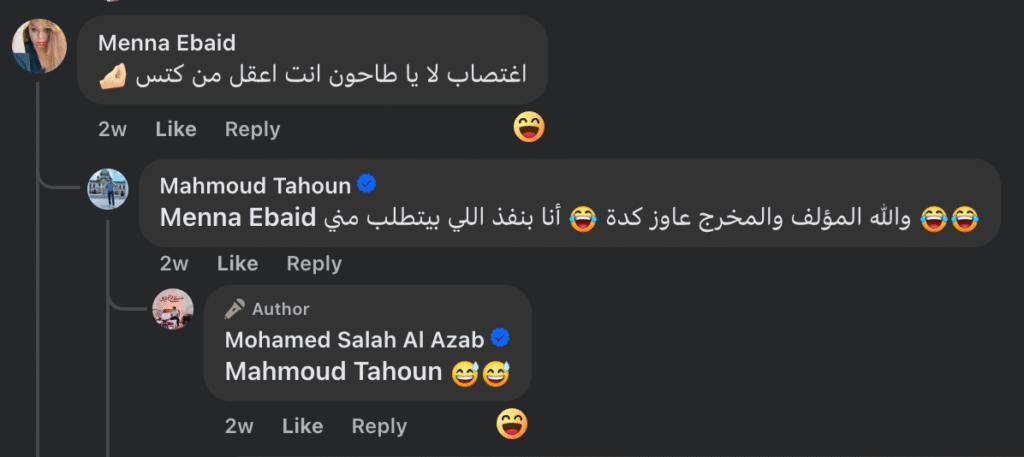
There’s also absolutely no mention of an intimacy coordinator—a role that’s crucial on any professional set with physical or sexual scenes to ensure all parties are comfortable and safe.
Rape scenes can be emotionally taxing, not just for actors, but for the crew. A responsible production brings in trained professionals to help mitigate trauma during and after filming. But not here. These guys think rape is just part of the entertainment package.
Now, if you think it’s based on the real story, think again!
In an interview with Al Arabiya, El Azab said:
“the film is inspired by a real story, but it can’t be completely real.”
On paper, that sounds like a responsible disclaimer. In practice, it doesn’t match the marketing.
El Azab’s phrasing “inspired by” suggests a dramatized reimagining, allowing creative liberties. Yet the marketing veers heavily toward presenting the story as real, complete with eerily specific posters and immersive teasers.
The posters, teasers, and social media posts lean heavily into presenting it as the real Safah El-Tagamoa story, complete with Ahmed El Fishawy mimicking the killer’s mannerisms.
When your promotional campaign recreates a killer’s real-life content for engagement, the so-called “fiction” starts looking a lot like a sales pitch for reality.
That kind of packaging blurs the line between fictional adaptation and living trauma, especially problematic when the subject matter is recent and painful.
The Lack of Respect is just Appalling
In all the promotional noise, the press releases, the social media posts, the giddy interviews, there is one thing you won’t find: any mention of permission from the victims’ families or the killer’s ex-wife.
This isn’t a small oversight. When you profit off real people’s trauma—people who are still alive and healing—you need more than legal clearance.
You need moral clearance. Their story isn’t a free-for-all. The timing is particularly egregious.
The film’s announcement coincided with a pivotal moment in the real-life case.
In July 2025, news broke that the killer’s ex-wife, Lubna Ghanem, had finally regained custody of their son after the killer’s mother was jailed for refusing to comply with court orders. The very same month, El Fishawy chose to announce the film with a celebratory post.
The ex-wife, Lubna, has been vocal about her suffering, detailing how her ex-husband tried to kill her and her sister, and even kidnapped her son. She fought a long legal battle to get her child back. Now, her life story is being turned into a dramatic film, with Cynthia Khalifeh cast to play the role of “Lubna.”
The question remains: were the feelings of the real woman behind the character respected?
As for the families of the three victims, they have not made any direct statements, but it is highly unlikely they were consulted. The pain of these families is undoubtedly renewed with every memory of the case, so what about watching what happened represented in a movie?
The ethical challenge is clear: will the film serve as a form of justice for the victims or as a profitable piece of entertainment built on their pain?
The “true crime” excuse doesn’t cut it. The killer has not even faced final justice; his death sentence has not been carried out. The families have not had years to process the grief. This is not a historical drama. This is fresh, open-wound territory.
No one is saying the story of Safah El-Tagamoa should never be told on screen. But you don’t get to mine someone else’s tragedy for box-office buzz without showing basic respect.
That means waiting until the dust has settled.
It means not treating the killer like a pop-culture anti-hero.
And it definitely means not dropping your big reveal on the same week the victim’s family finally gets a sliver of peace.
Right now, the film doesn’t look like a bold artistic statement. It looks like a rush to cash in while the people who lived this nightmare are still trying to wake up from it. And quite frankly, everyone involved in this project should be deeply ashamed — especially the women.



